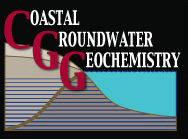Low Temperature Hydrothermal Vent Fluxes as Traced by Radium Isotopes
This project proposes to quantify key rates of iron (Fe) transport above a major ocean spreading center in order to evaluate the role of hydrothermal venting in supplying iron, an essential micronutrient, to the surface ocean. Iron is one of the most abundant elements in fluids emanating from mid-ocean ridges, but only recently has tantalizing evidence emerged that it can persist for long enough to play a role in global ocean biogeochemical cycling. Even more recently, a study of global hydrothermal Fe fluxes concluded that the deep ocean inputs could only be balanced with the addition of a low-temperature diffuse Fe source. Further, a significant fraction of dissolved Fe in low temperature fluids may arrive at the seafloor in a stable form that would mitigate significant removal during transport. It is therefore possible that low-temperature fluids may supply a disproportionate amount of the “transportable” dissolved Fe that has been observed in large-scale deep ocean plumes.
Assessment of process rates will be accomplished through concurrent measurements of Fe concentration and speciation and the radium “quartet” (224Ra, 223Ra, 228Ra, 226Ra) during an expedition along the southern East Pacific Rise (15°S-18°S). Autonomous underwater vehicle and towed-CTD surveys will be used to identify locations of low- and high-temperature discharge. At selected target areas, we will test the hypotheses that low-temperature hydrothermal inputs have a distinct radium isotopic ratio fingerprint, and that the relative rate of Fe scavenging removal is lower in low-temperature sources. Given their wide ranging half-lives, Ra isotopes have the unique ability to integrate over biogeochemically-relevant time scales of Fe transport in the deep ocean.
What will we learn?
The combination of concurrent Ra isotope and total dissolved Fe measurements will allow us to quantify Fe residence time for any Fe phase that is transported on large horizontal scales, as has been observed previously along the EPR.
Together, Fe loss and transport from Ra measurements will lead to improvements in the predictive capabilities of ocean circulation and biogeochemistry models that assess the importance of hydrothermal Fe in supporting primary productivity and carbon drawdown in overlying surface waters.
Scarce supply of the micronutrient Fe to surface waters limits the productivity of marine ecosystems in a large portion of the world’s oceans. While the significant contribution of hydrothermal sources to the deep ocean Fe inventory is established, this source is thought to be minor with regard to surface waters. Quantifying low- and high-temperature hydrothermal Fe inputs, losses and transport rates will allow us to assess the strength of this mechanism, and also reduce the large uncertainty in current model estimates of Fe residence time in the ocean – a key factor limiting our understanding of the sensitivity of marine systems to perturbations in the Fe cycle.
Related
- Kipp, L., Sanial, V., Henderson, P.B., van Beek, P., Reyss, J.-L., Hammond, D.E., Moore, W.S., Charette, M.A. (2018) Radium isotopes as tracers of hydrothermal inputs and neutrally buoyant plume dynamics in the deep ocean. Marine Chemistry, 201, 51-65.

